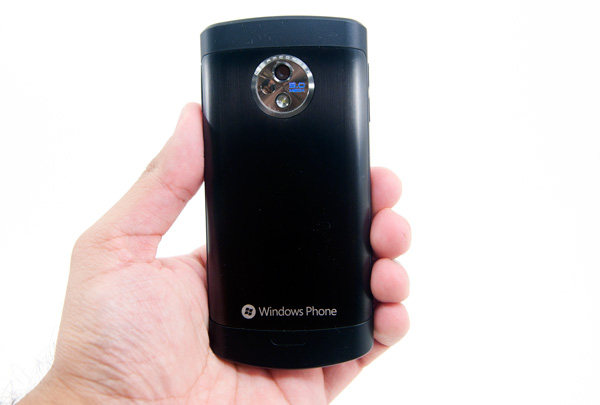LG's Optimus 7 & Samsung's Focus Reviewed: A Tale of Two Windows Phones
by Anand Lal Shimpi on December 3, 2010 10:14 PM EST- Posted in
- Smartphones
- Samsung
- Windows Phone 7
- LG Optimus
- LG
- Samsung Focus
- Mobile
Camera
Comparing smartphone cameras isn’t as easy as you’d think. You can take a bunch of shots in similar settings with different phones, but as with most things in this industry the manufacturers are all engaged in a high stakes game of tradeoffs. The obvious tradeoff up front is sensor quality vs. cost, once you make that tradeoff however there’s a lot more to worry about.
Much of how these cameras behave is up to software. There are certain things the iPhone’s camera does extremely well, and other things it just can’t ever seem to get right (e.g. white balance in certain types of CFL light). There’s also the debate of capturing reality vs. capturing what looks good. Oversaturating colors and employing TV-maker-style tricks come to mind here.
The Windows Phone 7 cameras we’ve played with have all been able to produce decent photos for web use. Given enough light and a very steady hand, you can even produce some sharp enough shots for small format prints.
I mention needing a steady hand because you are forced to use the physical shutter release button on the phone itself. The act of pushing down the button is often enough to blur a relatively slow rolling shutter.
Despite Microsoft mandating that all Windows Phone 7 devices have at least a 5MP camera, and supplying the default camera app, settings do vary between devices. For example, the HTC Surround allows you to set capture resolution but not compression level. The Focus and Optimus 7 let you do both.
The Optimus 7 adds a bunch of scene settings driven by LG’s own customizations, while the Focus has an option to enable “wide dynamic range”. The full breakdown of what you can do on these three phones is in the table below:
| Windows Phone 7 Camera App Settings Comparison | ||||
| HTC Surround | LG Optimus 7 | Samsung Focus | ||
| Scenes | Intelligent Shot | AF Mode | ||
| Effects | Beauty Shot | White Balance | ||
| Resolution | Panorama shot | Image Effect | ||
| Metering Mode | ScanSearch | Contrast | ||
| Flicker Adjustment | Photo Resolution | Saturation | ||
| Brightness | Sharpness | |||
| White Balance | EV | |||
| Color effect | ISO | |||
| Quality | Metering | |||
| Anti-shake | Photo Quality | |||
| Wide Dynamic Range | ||||
| Photo Resolution | ||||
| Anti-Shaking | ||||
It’s perplexing. Given how strict Microsoft has been elsewhere in the OS, even mandating what Start screen tiles OEMs/carriers are allowed to customize, this seems like a tremendous oversight. At the bare minimum all WP7 devices should have the same basic options to control things like JPEG quality and white balance.
The Focus has more normal camera settings while the Optimus 7’s settings are more geared towards scene control. The settings do tangibly change the image you get out of the camera in both cases.
Resolution options are also somewhat different between cameras. Although all three cameras have 5MP sensors the resolutions exposed vary among vendors:
| Windows Phone 7 Camera Resolution Settings Comparison | ||||
| HTC Surround | LG Optimus 7 | Samsung Focus | ||
| VGA (640 x 480) | 1M (1280 x 960) | VGA (640 x 480) | ||
| 1M (1280 x 960) | 3M (2048 x 1536) | 2M (1600 x 1200) | ||
| 2M (1600 x 1200) | 5M (2592 x 1944) | 3M (2048 x 1536) | ||
| 3M (2048 x 1536) | 16:9 1M (1280 x 720) | 5M (2560 x 1920) | ||
| 5M (2592 x 1944) | 16:9 2M (1920 x 1080) | |||
| 16:9 3.6M (2560 x 1440) | ||||
All three phones above feature a 4:3 5MP sensor. Only the Optimus 7 lets you shoot in a cropped 16:9 mode however. Samsung also crops its 5MP mode to 4,915,200 pixels, while the other two phones give you 5,038,848 pixels in their highest resolution mode. It’s not a big deal by any means, but curious nonetheless.
So how do these phones function as cameras? Both feature an LED flash, although the Optimus 7’s lens/flash cluster looks a bit fancier. As I mentioned before, I’d say both phones are easily capable of web quality photos; using the high resolution for detail in smaller photos vs. enabling huge images.
I’d argue that the Focus generally produces better looking images, at least more colorful, better exposed and marginally sharper ones.





























34 Comments
View All Comments
tonyfreak215 - Thursday, December 9, 2010 - link
You can pin a contact to the Main page. Just hold your finger on the contact and "Pin to start"EddyKilowatt - Monday, December 6, 2010 - link
During OLED's multi-year gestation, we saw lots of fetching display pics, though always with the text disclaimer "life of the organic emitters, however, remains a stumbling block".But now that products are on the shelves, the most penetrating journalism one can read about OLEDs amounts to, basically, "ohhhh... shiny!".
What is the backstory with OLED lifetime... was there a fundamental breakthrough that made it a non-problem, or was it merely increased "enough" that vendors think consumers will shrug and buy new toys when the old ones fade? Will today's eye-catching saturated colors look like old faded jeans at this time next year?
sviola - Monday, December 6, 2010 - link
Well, considering that people change cellphones in a 2-year schedule (usually when the plan is over), I don't think that the lifetime of the screen on a cellphone would matter much (2-year lifetime is around 17,5k hours if left on 24/7 - and I think Samsung AMOLED has a lifetime of 50k hours, which would translate to 5yr and 8mo of 24/7).xBabyJesus - Wednesday, December 8, 2010 - link
Anand, any chance you could do an update with read/write latency tests for a few flash cards? Apparently the sequential transfer speed (Class 2, 4, 6, etc) is pretty meaningless but the random read latency is make-or-break for Focus.